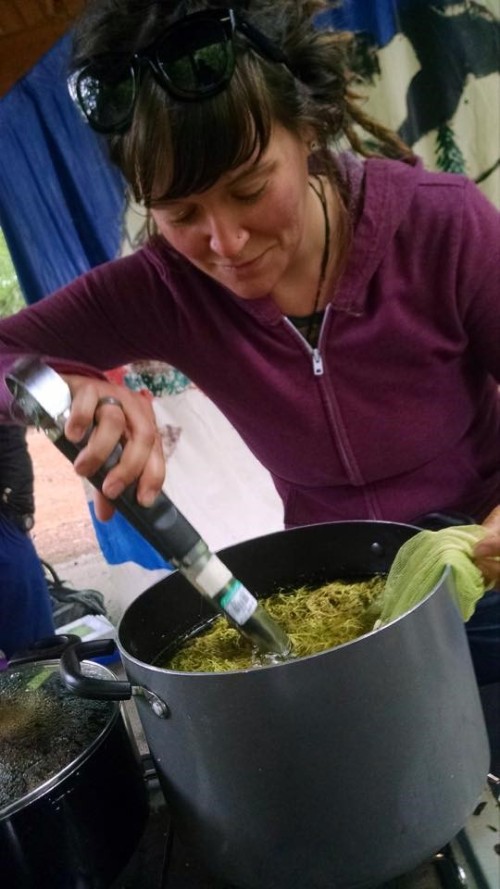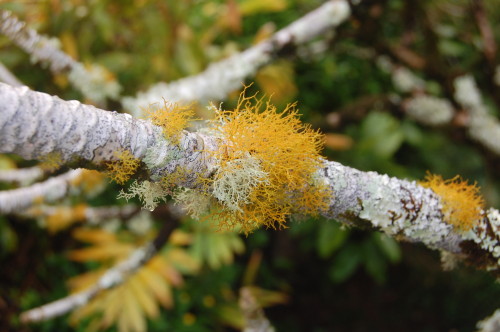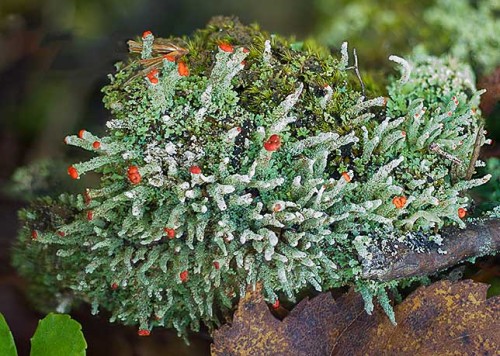Lichen Love: A Natural History of Lichen (Part Two)

By Kelly Sleight, graduate student in the institute’s 14th cohort.
Lichen and People
Lichen and people have interacted since time immemorial. Humans have used lichen as food, medicine, clothing, fiber, poison, decoration and dye. From the original Christmas tree tinsel to the cherished purple robes of the wealthy, lichen has played a huge role in our history.
Food
Many different cultures around the world used lichen as a food source. Often it was survival food because of the limited nutritional value. However, the Okanogan-Colville Native Americans valued the Black Tree Lichen or Black Tree Beard and included it as a staple of their diet. Traditionally the lichen was harvested, usually with Wolf Lichen, and cleaned extensively by the women of the Colville tribes. The Wolf Lichen is poisonous (used to tip hunting arrows), so it was important to fully clean the Black Tree Beard from the Wolf Lichen that often grew near and around it. The Black Tree Beard was then cooked in a pit fire with grasses, camas, spices, and deer meat for several days, resulting in a thick noodle-like consistency in the lichen. The women cooking the meal often fasted for the days it took to prepare and tended to the food preparation while remaining separate from the rest of the tribal community (Turner 1980).
Different people preferred Black Tree Beard from different host trees. The lichen often grows on many conifers in the Cascades and tastes differently depending on the host tree. Most Inland Skagit people prefer the Black Tree Beard from the fir trees, while Colville preferred Larch or sub-alpine fir (Turner 1980).
The Colville people also told a legend about Coyote who turned his hair into food after he was stuck in a tree. When Swan dropped Coyote from the sky, Coyote got stuck in a big fir tree. He escaped but much of his hair got stuck in the tree. He did not want his beautiful hair to go to waste so he turned his hair into food for his people (Turner 1980).
These days people still eat Black Tree Beard, however, thanks to modern technology a stew with Black Tree Beard can be cooked and prepared in an hour with a pressure cooker (Wooten 2015).
Medicine
Before modern medicine, one of the most practiced forms of natural medicine was based off the Doctrine of Signatures. The earliest documentation of this was in the early 14th century by Paracelsus stating, “Nature marks each growth…according to its curative benefit.” (“Doctrine of Signatures” N.D.). He taught that plants reminiscent of a part of the body or a symptom of disease are a sign that the plant is useful in treating afflictions of that part of the body or that condition. However, as science later discovers, many plants with medicinal qualities have nothing to do with the shape or color of their structure.
Bradley Bennet writes about this essentially, self-fulfilling prophecy in his essay, “Doctrine of Signatures: An Explanation of Medicinal Plant Discovery or Dissemination of Knowledge?” In essence, medicinal use for a plant was discovered and soon people began to find similarities between said plant and the human form. So perhaps they were not signatures of the plant but instead of the humans using them (Bennet 2007).
Needless to say, lichens did not escape this Doctrine of Signatures. For many years various lichens were tried as treatment for ailments such as jaundice, rabies and even hair loss. However, the only treatment that retained any value was Lungwort, or Lobaria pulmonaria. The lobes of the lichen along with the distinct lung like appearance of the organism made it seem that the lichen would be an ideal treatment for respiratory problems such as asthma and pneumonia (Turner 1980).
As it turns out, Lobaria pulmonaria was tested for its medicinal uses and has proven to have compounds that are effective against tuberculosis bacteria (Brodo 2001). Many different lichens were then scanned for medicinal purposes and it has been found that about 50% of lichen species have antibiotic properties and several are effective in curing boils, scarlet fever, and pneumonia (Brodo 2001).
Clothing
Lichen was sometimes used as clothing when other fibers were not available. Though not particularly comfortable or durable, they were an abundant source for the Colville and other Pacific Northwest tribes. When woven with other fibers it was common to find lichen in vests or pants, and not at all uncommon to be seen as hair decoration (Turner 1980).

Lichen as Natural Dye
The most prominent use for lichen that I found in my research was regarding its properties as a natural dye. Use of lichen as a natural dye was first mentioned in the Bible! When the world was seeking deep purple dyes for the wealthy they began by using a gland in shellfish to produce something known as Murex (Wooten 2015) (Casselman 2001). Murex produces a rich purple color and can be harvested from the hypobranchial gland of marine mollusks. However, it would take yards and yards of mollusks to produce enough dye for a single robe, and the mollusks began to be overharvested. Thus began the use of lichen as a dye source for purple. Originally, dyers would use a mixture of Murex and Roccella or Orchil dyes in order to produce more quantities of purple dye (Casselman 2001). Yet the mollusks were still devastatingly overharvested and lichen was soon the only source for purple dyes.
Lichens like Ochrolechia, Lasallia, Umbilicaria and Roccella began being harvested and dyed using ammonia. Peasants would sell their urine and this would serve to begin the fermentation of the dyes. During the Medieval and Renaissance times this ammonia dye method appeared to be the prominent way of working with lichen. However, it is difficult to determine the exact recipes and methods used from these early years since there was so much variation in recipes and equal variation in species used (Casselman 2001).
Yet much of the early work done by Native American and English indicate using boiling water method instead of ammonia method to extract lichen dyes. Granted the boiling water method or BWM would not produce the vibrant purples so sought after by the Medieval wealthy, but there was a wide variety of color that could easily be produced for clothing, baskets, and decorations (Casselman 2001).
One of the most used lichen for dyes by Native Americans was Letharia vulpina or Wolf Lichen. The vibrant yellow that was produced was prized for dancing blankets and a valuable trade item throughout the Coast Range and all the way to Arizona. Scotland also valued their lichen dyeing tradition and would dye their tartans, kilts, and jackets with crottle and corkir (Casselman 2001). Scotland still honors this tradition of lichen dyeing through the company Harris Tweed, which makes its tweed coats using lichen dyed wool (BBC Coast 2014).
Lichen dyes were very prominent up until 1856 when the discovery of a mold was made that could be used to industrialize dye, which was probably very beneficial for lichen populations. Yet some people are turning back to the ways of natural dyes and lichen dyes are an easy introduction into the field of natural dyes. Though lichen itself can be difficult to identify, simple boiling water methods of dyeing produce vibrant colors that do not take long to absorb and need no mordent or additive to bite into the material (Ashford 2015).

Preparing a Dye Bath
The two easiest ways to prepare a dye bath are the ammonia method (AM) and the boiling water method (BWM). The ammonia method requires some sort of ammonia, which human urine is an excellent source of, for those wishing to keep it completely natural. Ammonia method typically will produce richer reds or purples, while boiling water method will make earth tones.
There are very sophisticated procedures for both dye bath methods. For example, probably the most complicated method is the triple extraction method for BWM. The process involves cutting the lichen into small pieces, covering two cups of cut lichen with water, and letting the lichen soak for 24-36 hours. Then the lichen and water mixture is boiled and left for 30 minutes. The mixture should then simmer for additional hour. Then drain the mixture, leaving the water as the first phase of the dye bath. Cold water is then added to the lichen remnants, and the process is repeated two more times. Once the dye bath is finished, the liquid should be reheated in its entirety just under the boiling point. Add the fiber to the dye bath and let simmer for 2 to 3 hours (Casselman 2001).
When preparing my own dye baths, I decided on a much more simple procedure, which resulted in some very cool colors and a far less time consuming preparation. I cleaned the lichen and then placed the amount that I would be using, in my case two or three handfuls, into boiling water. I then let this sit overnight. The following day I added fiber to the dye bath and brought the whole thing to a boil. I let the whole mixture boil for about an hour, though the proteins picked up the color within 15-20 minutes of entering the dye bath.
The ammonia method is simpler but takes a longer time to produce the dye bath.
Since the lichen has to undergo fermentation in order to produce the dye bath the whole procedure can take up to a month. Like the boil water method, two cups of lichen particles should be soaked for 24-36 hours. The soaked lichen is then combined with three cups of ammonia and three cups of water, and the entire mixture must be in a sealed container where it must steep for three to sixteen weeks. During this time, you should shake the mixture three to five times a day to allow for aeration. Once the dye is ready for use, the fiber can be added to the dye bath and soaked for 36 hours to allow for full color extraction (Casselman 2001). My own ammonia bath took followed these directions and I am currently in the process of soaking fiber to extract color from the dye bath!
Kelly has also written Part One of this series on Lichen.


The punctelia rudecta (found on on fallen tree limbs in my yard) makes a vivid purple dye in just 4 weeks using the AM method. This is very different from the 16 plus weeks that Casselman says are required for North American AM lichens.